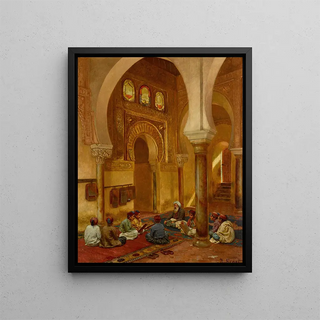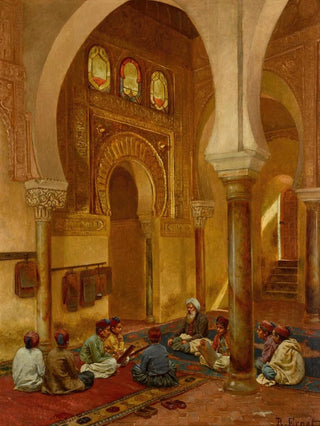Art print | In the Madrasa - Rudolf Ernst


View from behind

Frame (optional)
Art print in the rich and vibrant world of Orientalist art, Rudolf Ernst's "In the Madrasa" stands out for its evocative power and narrative depth. This painting, a true window into a fascinating world, immerses us in a scene of life within a Quranic school, where light and shadow dance beneath majestic vaults. The artist, through his skill in capturing the essence of the Orient, invites us to share a suspended moment, charged with spirituality and culture. Every detail, every color, seems to vibrate with a story to tell, offering the viewer a complete immersion into a universe that is both mystical and tangible.
Style and uniqueness of the work
Rudolf Ernst's style is characterized by an exceptional mastery of light and color. In "In the Madrasa," he plays with warm, golden nuances that illuminate the walls adorned with geometric patterns, while shadows create an atmosphere of mystery and serenity. The composition is carefully orchestrated, highlighting not only the impressive architecture of the madrasa but also the human figures that move within it. Each character is depicted with particular attention to clothing details and facial expressions, reflecting daily life and human interactions within this sacred setting. Thus, the artwork transcends simple representation to become a true tableau of life, where each element contributes to the harmony of the whole.
The artist and his influence
Rudolf Ernst, born in 1854 in Vienna, is one of the most emblematic artists of 19th-century Orientalism. His passion for the Orient led him to travel across Morocco, Algeria, and Egypt, experiences that profoundly nourished his work. Influenced by the great masters of his time, he developed a unique style, blending realism and romanticism, while immersing himself in the cultures he encountered. His paintings, including "In the Madrasa," are a perfect example, demonstrating a deep respect for the traditions and lifestyles he observes. By incorporating folklore elements and scenes of daily life, Ernst not only popularized the

Matte finish

View from behind

Frame (optional)
Art print in the rich and vibrant world of Orientalist art, Rudolf Ernst's "In the Madrasa" stands out for its evocative power and narrative depth. This painting, a true window into a fascinating world, immerses us in a scene of life within a Quranic school, where light and shadow dance beneath majestic vaults. The artist, through his skill in capturing the essence of the Orient, invites us to share a suspended moment, charged with spirituality and culture. Every detail, every color, seems to vibrate with a story to tell, offering the viewer a complete immersion into a universe that is both mystical and tangible.
Style and uniqueness of the work
Rudolf Ernst's style is characterized by an exceptional mastery of light and color. In "In the Madrasa," he plays with warm, golden nuances that illuminate the walls adorned with geometric patterns, while shadows create an atmosphere of mystery and serenity. The composition is carefully orchestrated, highlighting not only the impressive architecture of the madrasa but also the human figures that move within it. Each character is depicted with particular attention to clothing details and facial expressions, reflecting daily life and human interactions within this sacred setting. Thus, the artwork transcends simple representation to become a true tableau of life, where each element contributes to the harmony of the whole.
The artist and his influence
Rudolf Ernst, born in 1854 in Vienna, is one of the most emblematic artists of 19th-century Orientalism. His passion for the Orient led him to travel across Morocco, Algeria, and Egypt, experiences that profoundly nourished his work. Influenced by the great masters of his time, he developed a unique style, blending realism and romanticism, while immersing himself in the cultures he encountered. His paintings, including "In the Madrasa," are a perfect example, demonstrating a deep respect for the traditions and lifestyles he observes. By incorporating folklore elements and scenes of daily life, Ernst not only popularized the






